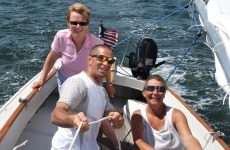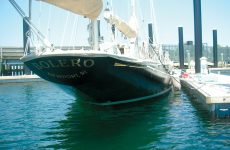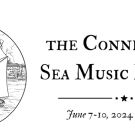
For his dream boat, the author would start with Arion. Photo courtesy Damian McLaughlin
July 2023
By Don Street
In his Guest Perspective (“A Fortuitous Pierhead Jump”) in the June issue, Don tells how an impromptu sail off Jamestown, R.I., on the iconic A. Sidney DeWolf Herreshoff ketch Arion conjured the seed of a dream, to design his perfect cruising boat. What follows are the details that materialized.
All my life, I have been a frustrated yacht designer. In the past 80 years on the water, I have cruised or raced on all types of boats, from 15-foot Snipes to Adix, a 175-foot three-masted schooner. As a result, I can never sail on a boat without taking notes on how I think the boat could be improved.
Read about yacht designer Chuck Paine’s take on Arion here
If I were to win the lottery, I would build a replica of Arion. I would raise the freeboard four inches, and the cabin sides two inches to give a full six feet and change of headroom for my tall friends. I’d add a foot more beam to open up the main cabin.
She would be built of 3/4-inch strip plank, with two light layers of wood epoxy glued in place on top, double-diagonal covered with Dynel laid in epoxy. She would be considerably lighter than a fiberglass hull, so the keel could be 1,000 pounds heavier than the existing keel, yet only increase displacement by 300 to 400 pounds. The heavier keel, plus the slight increase in beam, would give her a little more sail-carrying ability.
Accommodations would be basically the same, but the cockpit would be shortened by two feet. It would still be six-feet long, adequate enough for sleeping on deck on hot nights. This would give two feet of space at the forward end of the main cabin to install a proper coal stove and coal locker for fuel supply. With a main cabin kept warm and dry by a coal stove, the cruising season could start really early and continue late in the year. Certainly, with a coal stove, an Arion offshoot could cruise into December.
I would leave the rig basically the same except I would have an aluminium mast, and thus dispense with the running backstays. I would install a stub bowsprit approximately two feet long so an anchor could be stowed permanently clear of the bow. I would move the jibstay two feet down.
I would tack down to the bowsprit end a light-airs set up: a top-down roller furling light genoa, with the new Harken luff. It would be a 150, perhaps 160, light genoa of about 600 square feet. The clew would be high enough so that when sheets were eased it would be sheeted through a block at the end of the main boom. When reaching, doing this opens up the slot, allows the main to be eased, and increases boat speed by about a knot with the genoa sheeted to the rail cap.
Rod Stephens used this rig on the J-Boat Ranger. Arthur Knapp, who was aboard Ranger as a sail trimmer, taught me how to do this on the original Ondine while I was her paid skipper, right after graduating from college. I used this rig on Iolaire. I have, when reaching, rigged headsails through a block on the end of the main boom on every boat I have sailed on, when I have been allowed to do so. It has always increased speed while reaching by 0.5 to 1.5 knots.
The mizzen would be rigged like Iolaire’s, with sharply-raked spreaders and no mizzen running backstays. In 1947, my parents brought back from England a number of Uffa Fox books. In one book, Uffa stated: “If a shroud is given one inch of drift aft for every one inch of height, a shroud will also become a backstay.”
This is what I did on Iolaire, with the mizzen we salvaged from the wreck of the Ondine. Iolaire’s mizzen is stepped on deck, and has no running backstays. Despite the big mizzen staysail being 600 square feet, the mizzen has never gone over the side.
Needless to say, on my dream boat I would regularly be setting a big mizzen staysail of 240 square-feet. It would be the same size as the main. In light airs, with the big genoa, main, mizzen and mizzen staysail, she would be setting 1,100 square-feet. She would fly, and she’d keep moving in drifting conditions.
As noted on my pierhead-jump sail [in the June issue of Points East], at the end of the day, under main and jib only, 410 square-feet, in 15 to 18 knots of wind, close-reaching, we were doing a solid nine, surging to 9 ½ and 10 kts. With 1,100 square feet, she would fly, even in the lightest of air.
The anchor, a plow-type, would be stowed in chocks in the bowsprit, with the chain run aft through a gravity chain-stopper along the deck. It would be mounted on a sacrificial, thin, replaceable iroko chafe strip to a windlass or capstan beside the mast. Iroko is the most chafe-resistant wood in the world, from my personal experience. The chain would feed into a narrow, vertical chain locker.
When at anchor, she would ride to a 20-foot length of nylon secured to a chain hook. The nylon would be secured to a cleat, and the chain slackened so it hangs in a bight, the chain secured by a gravity chain ratchet. Spare anchors – aluminium ones of different sizes that disassemble – lengths of chain, and lengths of nylon all would be stowed in cockpit lockers.
Auxiliary power needs would be minimal. I would install a small electric motor of the latest type that will regenerate starting at four knots. I would have enough batteries to provide about four hours at five knots, under battery power alone, in flat calm. Battery power would be for entering and leaving marinas, or to reach an anchorage if the wind goes completely flat. The electric motor would recharge the house batteries, but it would very slowly recharge the propulsion batteries. The propulsion batteries would be recharged from shore power when in marinas.
There would also be a silent wind generator at the top of the mizzen-mast. On the main-cabin top, or perhaps the after-cabin top, I’d want some solar panels – of the type that can be walked on – to back up the wind-charger while at anchor, or when the wind is too light to turn the wind charger. She would be a completely green boat that would cruise with zero carbon emissions. With all LED lighting and minimal electronics, there would be enough electricity to run a small refrigerator to keep my Heineken cold.
The above is the description of my dreamboat. At 92, I can say with certainty that when you no longer dream, your life has ended.
Nonagenarian Don Street cruised on his Iolaire, a 46-foot, 1905 engineless yawl for 52 years, chartering, exploring, charting, and writing about the Caribbean and the Atlantic Islands. His first book, in 1966, was “A Cruising Guide to the Lesser Antilles,” regarded as the text that opened up the Eastern Caribbean to cruisers and greased the skids for the bareboat-charter business. Charts and guides for the Caribbean and the North Atlantic islands followed. He still races his Dragon Gypsy, which, at 92, is the oldest of its class still racing.










